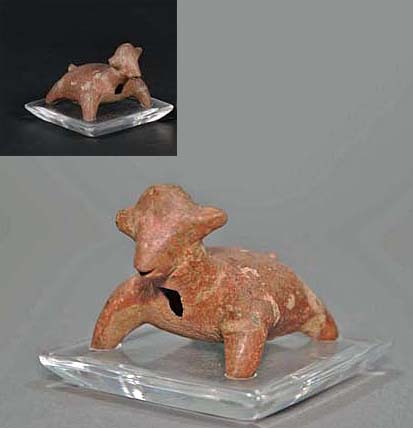
Owner: HWMC
Catalog#: LA-AEWF-19
Edge-blown Flutes
Mexico ‘Colima Dog’ Ocarina
West Coast Mexico
Colima (Otomies)
Terra cotta
ca. 250 CE
Length: 3.5 in, Width: 2.5 in, Depth: 2 in
Aerophones – Wind Instruments Proper – Edge-blown Flutes
The ocarina is a variation of the ancient wind instruments known as vessel flutes. It is somewhat globular in shape contrasted to the elongated tubular flute. Ocarinas are made in a variety of shapes and sizes.
This Pre-Columbian Colima terra cotta ocarina is in the shape of a Mexican short ear, hairless dog. It is a representation of Xoloitzcuintle, more commonly referred to as Xolo. Not only did these domesticated dogs provide an opportunity for food, but they also served spiritually as a part of ceremonial and religious life. They were thought of as guides and companions for humans in the afterlife.
To play the ocarina, air is blown through the hole in the top of the dog’s head. The hole at the bottom of the dog’s throat allows for a column of air to split, creating a whistling sound. The two finger holes under the belly of dog permits the player to change the pitch when opening and closing the holes.
Colima is a state name and is also the name of the capital city. The people in this region, who settled in Prehispanic times, came by successive waves of people arriving from the north: the Otomies may have come through the area around 250-750 CE, followed by the Toltecs who flourished between 900 and 1154 CE, and the Chichimecs who came to the area during the twelfth century. This ocarina dates back to the Otomies and Prehispanic times.
